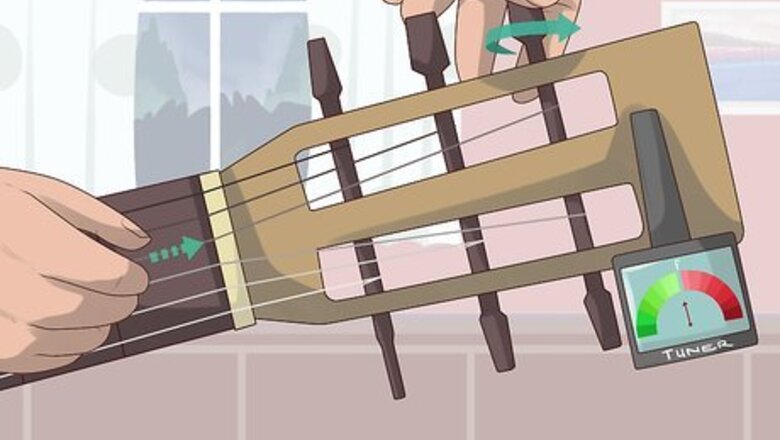
views
Checking Relief at the Neck
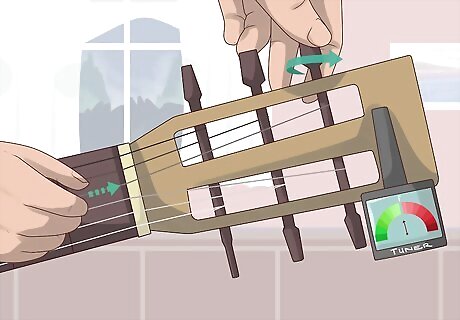
Tune your guitar to proper pitch. Make sure your guitar is in tune so the strings are at their proper tension. The neck naturally moves when the strings are off or out of tune, so you want to make sure it's in proper position. With your guitar in tune, you're going to check to make sure that there are no warps or bends in the bridge that could cause the action to be uneven and make your guitar harder to play.Tip: Extreme changes in temperature or humidity can cause the neck of your guitar to bow or warp. If your guitar has recently been subjected to such changes, adjustment of the truss rod to straighten the neck may be all you need to do to correct the action.
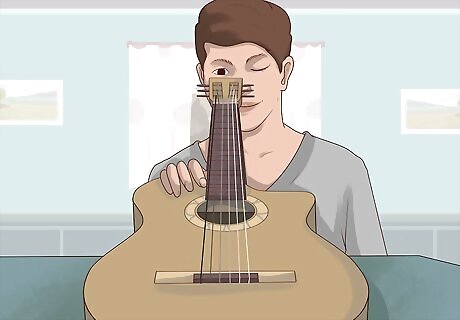
Sight the guitar neck from the headstock down towards the bridge. Turn your guitar on its side and hold it at an angle with the lower side of the guitar resting on the table and the headstock at eye level. Closing one eye, look down the side of the neck to see if it's straight. Turn the guitar over and look down the other side as well. The neck should be straight on both sides. You can also look down through the center of the headstock with your guitar resting on its back edge on the table. From this angle, you can more easily see if there's a bend in the neck. If this is your first time sighting the neck of your guitar, you may not know exactly what to look for.
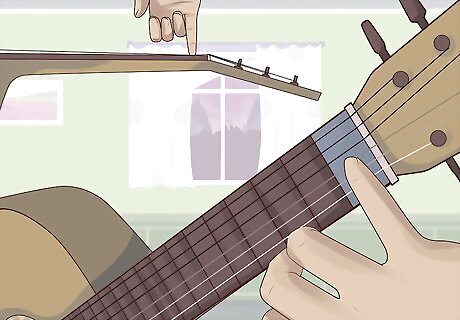
Use the tap test to gauge neck relief. Fret a string at the first fret, then press the string down with your pinky on the nearest fret where the neck joins the body of the guitar. This test can help you determine how much space there is between the string and the frets. Repeat the tap test with all 6 strings of your guitar. Since it takes practice to sight a guitar neck, this test can help you confirm your findings.Alternative Test: If you have a notched straight edge, place this along the neck of your guitar and hold the neck up to the light. If any light is coming through from the bottom of your straight edge, your neck is not straight.
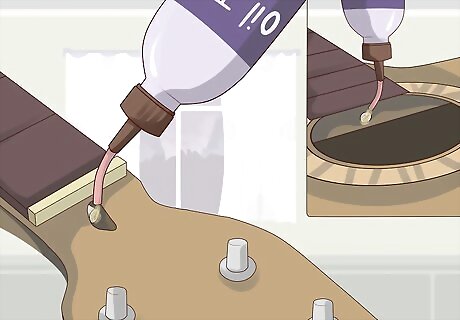
Expose the truss rod of your guitar. In your headstock, you'll see a little truss rod cover secured with micro-screws. Unscrew the cover and set it aside to expose the end of the truss rod. You may need to apply a small dab of oil or other lubricant to ensure it turns smoothly. Take care not to lose the truss rod cover or the screws. You can stick them temporarily to a piece of tape or the sticky part of a sticky note to keep them together. Some acoustic guitars are only accessible through the soundhole of the guitar. You'll be better able to get at the truss rod if you loosen your guitar strings so they aren't in your way.
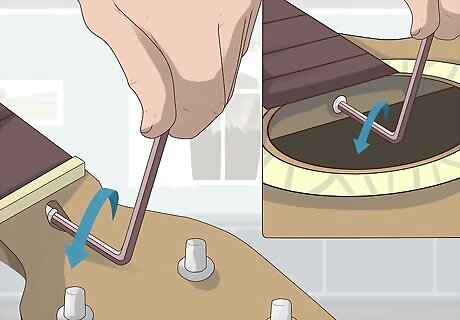
Turn the truss rod slowly and methodically. Choose the truss rod wrench that fits your truss rod and slowly turn it about 1/8 of a turn. Turn it left if you need to loosen the truss rod to add relief in the neck. Turn it right if you need to tighten the truss rod to eliminate excess relief or correct a back-bow. If you're accessing your truss rod through the soundhole of your guitar, you'll be using a longer truss rod wrench to reach it. Keep this in mind when adjusting it so you don't tighten or loosen it more than necessary.Tip: Make sure you have an adjustable truss rod. Some truss rods, particularly in older acoustic guitars, are not adjustable. If you have a non-adjustable truss rod and need to fix a bowed neck, take your guitar to an experienced luthier.
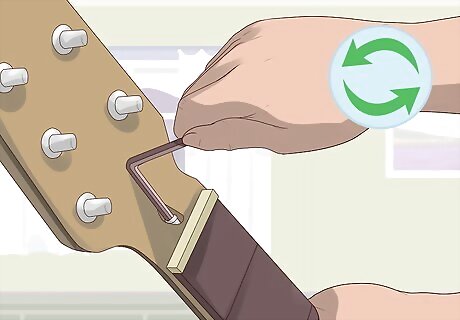
Repeat as necessary until your guitar's neck is straight. After you've made your first adjustment, tune your guitar back up to pitch and check the relief again. If the neck is still bowed, turn the truss rod another 1/8 of a turn. Then check it again. If this is your first time making this adjustment, you may have to go through this process 4 or 5 times before you get a straight neck. Just have patience. More experienced luthiers can tell exactly how much they need to turn the truss rod just by sighting the neck.
Measuring Your Guitar's Action
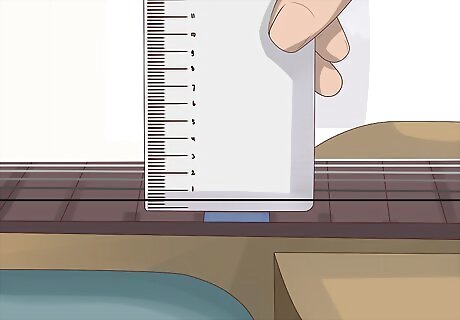
Measure your current action at the 12th fret. Make sure your guitar is tuned to pitch so you get an accurate measurement of the action. Place your string action gauge height ruler level with the neck and measure the distance between the string and the top of the 12th fret. You can use any reference point between the 8th and the 12th fret. Just make sure you use the same one every time. While you can use any sort of ruler for this measurement, string action gauge height rulers have much smaller increments, which will enable you to be more accurate.Tip: You can use a capo at the first fret to keep your nut height from affecting your measurements. If you do this, make sure you do it every time you check your action.
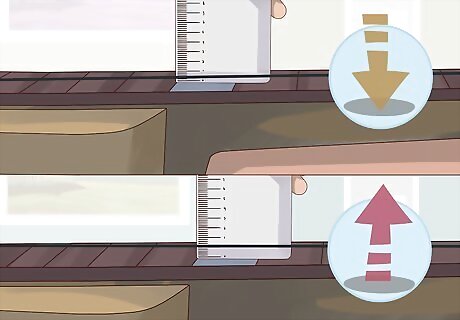
Decide whether your action is too low or too high. Whether your action is too low or too high is largely a matter of your own personal preference. It largely depends on what you're comfortable with as well as your playing style. If you fret lightly, you may feel more comfortable with a lower action and you likely won't have to worry about too much buzz. However, more aggressive players typically want higher action to avoid too much fret buzz. Acoustic guitars typically need slightly higher action than electric guitars. Keep that in mind if you have both or are switching from one to the other.
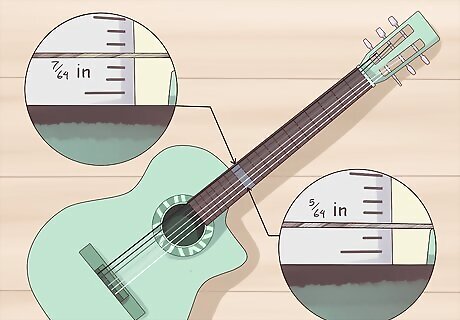
Check default action for the type of guitar you have. Each guitar has default action it's set to when it leaves the factory. If your guitar has been played a lot or been exposed to drastic changes in temperature and humidity, you may want to simply reset it to the default action. The specific default action depends on the type of guitar you have and the size of its neck. However, you can use general default measurements simply to determine whether your action is too high or too low: For electric guitars, the default action is typically ⁄64 in (0.24 cm) on the bass side and ⁄64 in (0.16 cm) on the treble side. For acoustic guitars, the default action is typically ⁄64 in (0.28 cm) on the bass side and ⁄64 in (0.20 cm) on the treble side.
Setting Action at the Nut
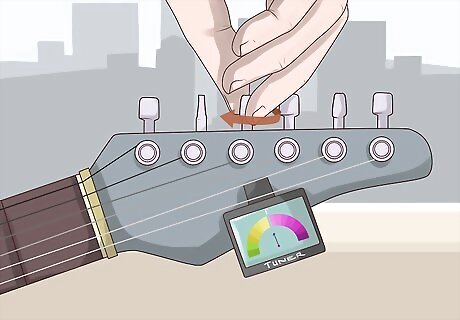
Bring your guitar up to pitch if necessary. If you've been adjusting the neck relief of your guitar, you may need to retune your guitar before you test the action at the nut. If your strings aren't at the correct tension your measurement will be off. You may not want to adjust the action at the nut at all if you frequently use alternate tunings or switch to different gauge strings. It will only make it difficult for your strings to sit right and you may have trouble keeping your guitar in tune.
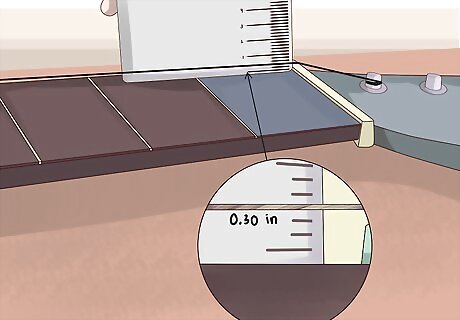
Check the height of the 6th string at the first fret. Place a feeler gauge on top of the first fret, between the string and the fret. Start with the smallest feeler gauge and move up to the next largest. Keep going until you feel the string move to accommodate the feeler gauge. The largest feeler gauge that will fit between the string and the first fret is the distance between the string and the top of the fret. This will give you an idea of how much the nut needs to be filed down (if at all). You can also measure with a gauge height ruler. The standard measurement at the 1st fret is 0.30 in (0.76 cm).Tip: High action at the nut can affect your guitar's intonation as well as cause the entire instrument to play uncomfortably.
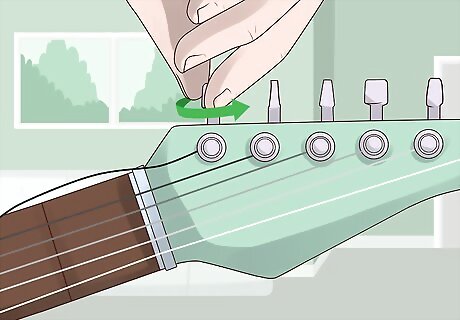
Loosen the tension on the string and place it to the side of the nut. Detune the 6th string until you can gently slip it through the notch and rest it on the side. Be careful not to rip them out because you can cause the edge of the nut to snap off. You can also rest the loosened string lightly on the top of the nut. However, don't try this until you have some practice as it can damage the nut.
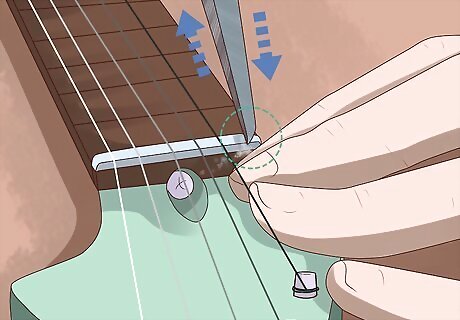
File the nut at an angle. Using the nut file for the 6th string, file the nut notch towards the headstock at the same angle as the headstock. Be careful not to file it flat. File a very small amount at a time, then replace your string and check the action. Repeat as necessary until you have the action you want. You may want to place a piece of plastic on the headstock between the tuners to protect it. Otherwise, you may accidentally file into the headstock.Warning: You can only lower the action at the nut. If you file too much, you'll need to get the nut replaced. The only way to increase the action at the nut is to have a new nut installed.
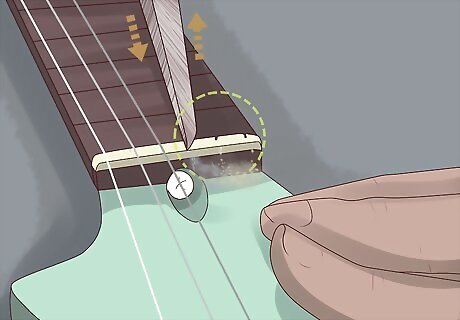
Repeat the process with each of the other strings. Once you've got the correct action at the nut for the 6th string, move to the 5th string and measure the action. File if necessary, then move on to the 4th string, and so on. For middle strings, make sure the strings are loose enough that they aren't resting directly on the nut.Tip: Typically, you want to lower the action at the nut, if necessary, before adjusting the action at the bridge. After lowering the action at the nut, measure your action again to determine whether any work at the bridge is necessary.
Adjusting Action at the Bridge
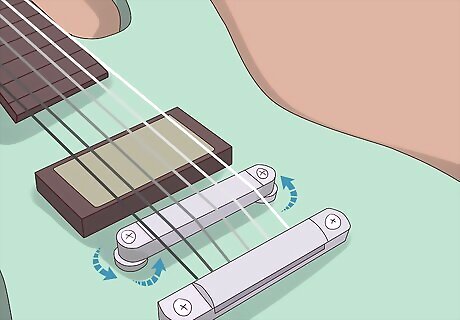
Change the bridge height of a Gibson-style bridge in 2 places. Gibson-style bridges have a screw on either side that you can use to adjust the bridge height. Turn the screw to the left to raise the bridge or to the right to lower the bridge. Retune your guitar and measure the action. The following are default Gibson action specifications: Electric: ⁄64 in (0.24 cm) on the low side, ⁄64 in (0.16 cm) on the high side Acoustic: ⁄64 in (0.28 cm) on the low side, ⁄64 in (0.20 cm) on the high side Bass: ⁄64 in (0.28 cm) on the low side, ⁄64 in (0.20 cm) on the high sideWarning: If you have a Gibson Tune-o-Matic bridge, you shouldn't need to adjust the action at the bridge. It is set at the factory.
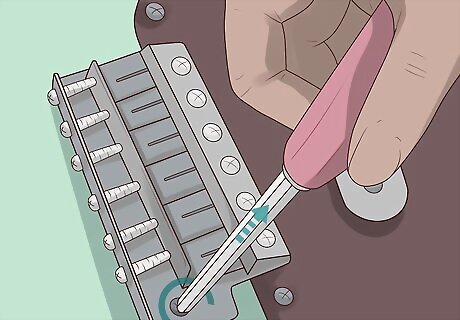
Set the action for each string individually if you have a Fender-style bridge. You have a little more control with a Fender-style bridge because you can adjust the action for each string rather than having to change the height of the whole bridge. Simply use the correct screwdriver to turn the screw at the bottom of the string and raise or lower the height of that string's saddle. Turn left to raise (increasing action) or right to lower (decreasing action). Once you're done, retune the string and check your measurement. Fender default action specifications are as follows: For a neck radius of 7.25 in (18.4 cm), string height should be ⁄64 in (0.20 cm) on the low side and ⁄64 in (0.16 cm) on the high side. For a neck radius of 9.5 to 12 in (24 to 30 cm), string height should be ⁄64 in (0.16 cm) on the low side and ⁄64 in (0.16 cm) on the high side. For a neck radius of 15 to 17 in (38 to 43 cm), string height should be ⁄64 in (0.16 cm) on the low side and ⁄64 in (0.12 cm) on the high side.
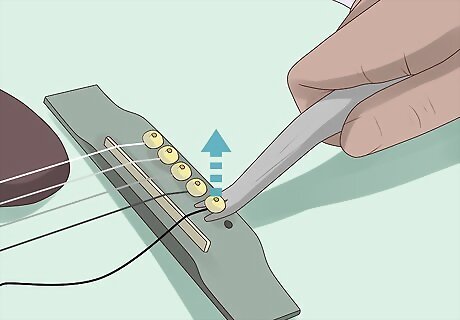
Remove the strings from the bridge on an acoustic guitar. If you have an acoustic guitar, you can't adjust the action at the bridge quite as easily as you can with an electric guitar. Because you'll need to sand down or add a shim to the bridge itself, you must first carefully remove the strings from the bridge so you can pull the saddle out of the bridge slot. Use your string winder to loosen your strings until they're floppy. You may not need to remove them entirely, which can save you some time. However, you do need to loosen them enough that you can remove them from the bridge. If your bridge is wedged pretty tight, you may need to use pliers to get it out. Take care not to scratch your guitar or damage the bridge or saddle.
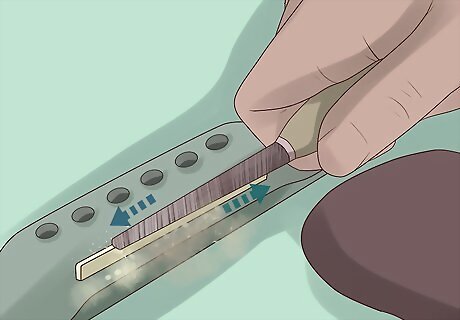
Sand down your saddle or add a shim. If you want to lower your action, use sandpaper to slowly and carefully sand down the saddle. If you want to raise your action, you'll need to glue a shim to the saddle (or buy a higher saddle). When sanding, be careful to keep it completely even. An uneven saddle will ruin the tone of your instrument. Do a little at a time, then replace your strings, bring your guitar back up to pitch, and check the action again. Be prepared to repeat this action several times, especially if you don't have much practice.Warning: Adjusting the action of an acoustic guitar at the bridge is an extremely delicate operation. If you sand too much, you could ruin your guitar or snap your bridge. If you don't have experience doing this, it may be better to simply take your guitar to an experienced luthier.
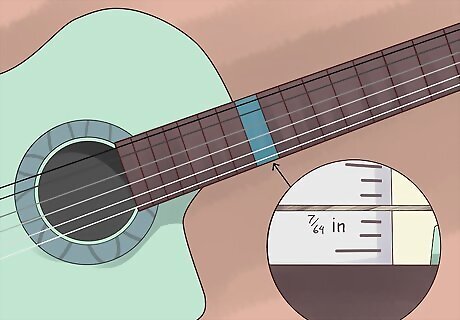
Check your action and readjust as necessary. Whether you have an acoustic or electric guitar, you may have to repeat the process of adjusting the action a few times before you get it right. Make sure your guitar is tuned to pitch and measure the action at the 12th fret as you initially did. If you've not yet hit your target, repeat the process of adjusting the action and try again. More than a specific measurement, pay attention to how the guitar plays and sounds. If you're getting a lot of fret buzz when you play your guitar, you've got your action too low. If it's not comfortable to play or you're having trouble fretting strings, you may have it set too high. Play around until you find what works best for you.


















Comments
0 comment